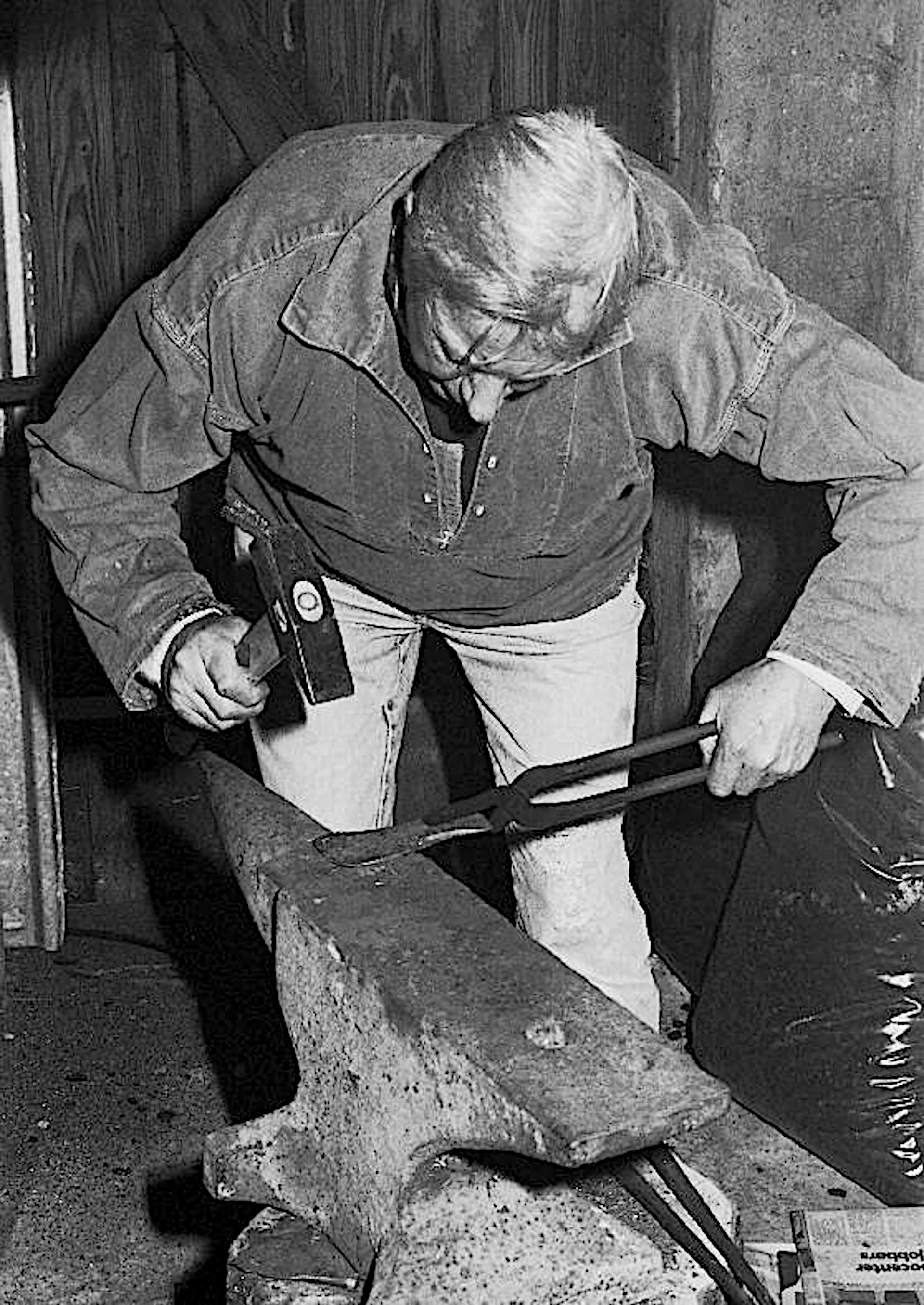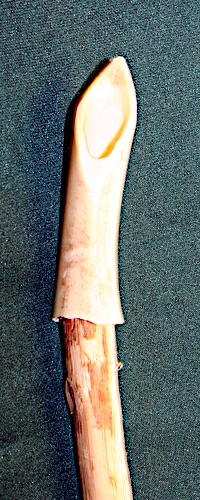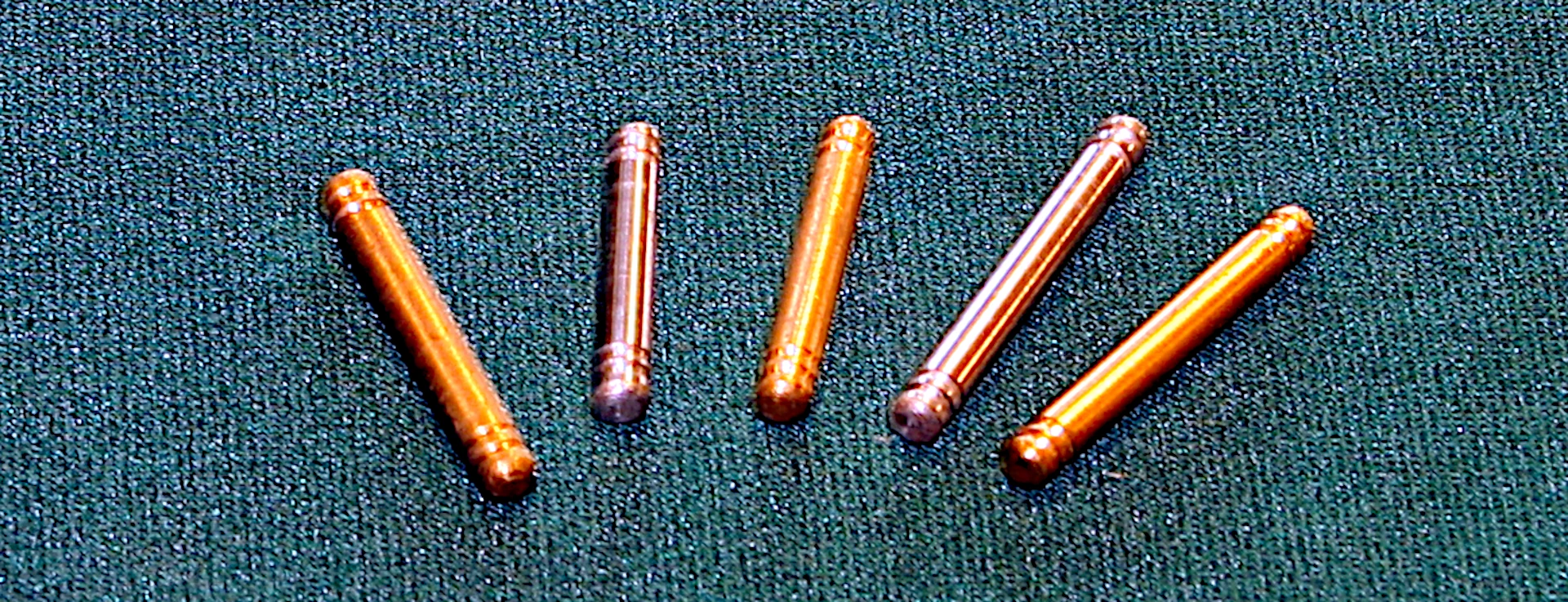Extract from the visit report
Visit[6] by Jørgen Skawbo (pictured below) to the National Museum on 1 November 1993.
Purpose: To measure spearheads and swords and look at details in order to make as accurate copies of the weapons as possible. During the visit, discuss any uncertainties regarding welding or other possible closures of sockets.
Together with Flemming Kaul (FK) (the author of ‘Da våbnene tav’), spearheads and swords were removed from the display case and brought to the library. The following numbers were measured (Rosenberg's numbering): Spearheads no. 350, 355, 357, 458. No. 356 could not be taken out immediately due to the way it was suspended, which is why I only saw and ‘labelled’ it. The swords no. 516, 524, and one selected from FK's book on the far right on page 24. No. 515 was on loan to Haderslev Museum.
The weapons are very fragile, as there are actually only iron oxides left of the formerly magnificent blank weapons. Therefore, they had to be handled with both hands for support and with full respect for the preservation of every little ‘shell’ on the eggs. To get as many measurements as possible taken with my caliper and ruler, I rotated and tipped the items while they lay on a white piece of paper on the table. Some desired measurements would be ‘pure guesswork’ due to the nature of the surface, so I omitted these measurements and left them to the outcome of the copies, as we - like the Iron Age blacksmith - must accept the result after ‘a job well done’.
With a magnifying glass, I searched for the joints of the sockets. I found no signs of joints at all and this could be due to 2 things. The black uneven oxide surface will hide a joint that a shiny iron surface would have revealed as a ‘line’ - or a weld has been made and therefore no visible joint. Ace welding of such thin material (immediately loses the ‘heat of fusion’ - or is destroyed by ‘heat’) is hard to believe in wholeheartedly. Most likely, the joints are either ‘overlapped’ and forged smooth - or made nice and straight and ‘butted’ tightly together and smoothed over a mandrel. A thin wooden handle would crack before a socket would open!
The target sketches contain my subjective comments.
According to Fl. Kaul welcomes us to visit the National Museum again. He looks forward to seeing the boat sail up Frederiksholms Kanal and dock at the museum.
J. Skawbo
After the image, examples of the replicas we have made of spears, lances and swords are shown.
Spears and lances
Different researchers have classified spears and lances into different classes, here three researchers are referred to:
| Spear / lance | Randsborg [1] | Becker [2] | Rosenberg [7] | The image above [3] |
| Short, broad spear head with centre rib, short socket, 5-16 cm long, - 5 cm wide. | Type 1 | A | α | C |
| Long, narrow spear head, sharp midrib, short socket, 13-29 cm long, - 3.2 cm wide. | Type 2 | B | β | B |
| Long, narrow bayonet-like, 13-25-43.5 cm long - 2.7-5.6 cm wide. Deep penetration. | Type 3 | γ | ||
| Strong, wide lance, 12-36.5 cm long, - 6.2-7.5 cm wide. | Type 4 | C | δ | D |
| Strong, wide lance, 29.5 cm long, - 7.5 cm wide. Copper inlay. | Type 4 | C | δ | A |
Iron spearheads
From the member folder
Measurement sketches for spears of different types
A description of our centre rib spearhead manufacturing
I have not been able to find any correspondence between our copies and the specific descriptions in Rosenberg, except for the first one, #355.
Examples of spears and lances representative of the classes defined by Randsborg are shown. Not all of our copies are shown.
Has a short broad spearhead with a centre rib and a short to very short socket, the length of the spear blade is between 5 - 16 cm and the width up to 5 cm. The spear has been a throwing spear. We have not made spears of this shape.
The one shown differs from the others in the group in that it is very long - almost 30 cm, and 7.5 cm wide. Furthermore, it has an internal socket. It was the only one with a decoration in the form of an inlaid copper band where the spear was widest, the band was 0.3 cm wide and 2.2 cm long and placed on both sides of the socket.
See a description of how spears with centre rib were made here.
Type 2
It has a long, narrow spearhead with a, usually, strong centre rib and a short soket, the length of the spear blade is between 13 - 29 cm and the width in the middle of the blade up to 3.2 cm. This shape appears to have been designed for deep penetration, perhaps in chain mail.
34 pieces of this type have been found.
Type 3
It has a long, narrow bayonet-like lance tip with a, usually, strong centre rib and a long socket up to 12 cm long, the length of the spear blade is between 13 - 25 - 43.5 cm and the width at the base of the blade is 2.7 - 5.6 cm. This shape also appears to have been designed for deep penetration. The lance has been a close combat weapon.
8 pieces of this type have been found.
Type 4
Has a powerful, striking, broad lance tip with a, usually, strong centre rib and a medium-length socket, the length of the spear blade is between 12 - 36.5 cm and the width at the base of the blade is 6.2 - 7.5 cm. The lance has been a melee weapon.
64 pieces of this type have been found.
Deer antler or reed bone spearheads
31 spearheads made from either antler or bone have been found.
There are two designs:
With a round base. 5 deer antler spearheads have been found, they are hollowed out for the shaft and have a transverse hole for the locking pin.
With three-sided base. 26 pieces found, made from sheep or goat tubular bones. These are cut at an angle to form a sharp point. These also had a transverse hole for a locking pin.
The locking pins for these spearheads are made of bone or wood.
Shafts
Broken shafts were found in most of the sockets at the edge of the socket. A few spears had longer shafts, up to ½ m. The diameter of the shaft outside the socket is about 4 mm larger than the diameter of the socket hole at the edge, so there was an edge. We don't know the shaft length for the different types of spears.
Throwing spears should probably have a shaft length of about 2 metres if the spear is to have a good flight in the air. The shafts are assumed to be made of ash.
Note: The shaft in the picture is additionally glued with resin glue, there is no documentation for this in the find. The spear has been on loan to Danmarks Radio in connection with the programme: The Story of Denmark, where we participated in Episode 2: The Age of Metal. To make sure it didn't come apart, it and the others on loan were glued.
Accessories for the spearheads
Iron or bronze pin/rivet
The pins are 28 mm long and Ø4 mm.
They are intended to hold the spear and shaft in place. A hole was drilled through the socket and shaft in the same plane as the spear blade, except in one case, the spear with an internal socket, where the hole was drilled perpendicular to the spear blade. The grooves at the ends of the pins can ‘catch’ the edge of the socket, preventing the pin from slipping out too easily.
See an example of the use of the pin in spear-B in the image above.
Alle spyd, også dem af ben eller tak, havde et hul til en sådan fastgørelse.
Swords
Parts of 11 swords have been found, 8 more or less whole and 3 in fragments. All the swords are single-edged with the grip tongue in the centre axis of the sword. The spine was in many cases very wide and the blade hollow-ground, see picture above. A few whole sword scabbards and fragments of a few others have been found. They were made from two thin ash wood plates held together by metal bands.
Rosenberg divides the swords into 3 groups: [5]
| Group | Description | The image |
| A | Includes 6 specimens. The 3, almost whole, are between 48.5 and 70 cm long and from 1.4 to 2.6 cm wide. The spines are between 8 and 10 mm wide. | A |
| B | Includes 2 specimens. One is 31.5 cm long and 3.5 cm wide at the top, bronze bands have been found for decoration at the hilt. The other is a powerful weapon, almost a cutlass, the blade is 28 cm long and 7 cm wide at the root, parts of the hilt have been found. The spine is not as pronounced on these two. | B, C |
| C | Includes 3 specimens. They all have flat surfaces and do not have a flared spine. The blades are from 36 to 45 cm long and between 2 and 3.5 cm wide. | D |
From the Member folder
Descriptions of the swords found, with comments.
Examples of swords are shown that are representative of some of the classes Rosenberg has defined.

Photo: Ib Stolberg-Rohr.
I have not found a description in Rosenberg that quite matches this sword, the closest one is #517[9] (A in the image above), however, this is 530 mm long and about 18 mm wide, where ours is 625 mm long and 35 mm at its widest point.

Photo: Ib Stolberg-Rohr.
Sword #524
Whether it's a sword, a cutlass or a knife for cutting small trees and bushes is difficult to determine[10]. In any case, it's a heavy one. The blade is 280 mm long and 70 mm wide. There were parts of a grip/handle, it was terminated at the blade with a 10 mm wide iron band and attached to the blade's grip tongue with two rivets. The shape of the grip is our interpretation.
This article was put together by
Notes and references
Kilder
KR. Randsborg, K. Hjortspring. Warfare and Sacrifice in Early Europe.
BC. Becker, C.J. Die zeitliche Stellung des Hjortspring-Fundes
SB5. Crumlin-Pedersen, O. et. Al. Hjortspring. A pre-roman Iron-Age Warship in Context
GR. Rosenberg, G. Hjortspringfundet.
MM. Member folder





![Spear classes according to Ships and Boats [3]. Drawing: B. Skaarup, [3]](https://hsbl2.dk/images/hsbl/Laug/Site/Menus/Recon/hsbl_recon_0030.webp)









